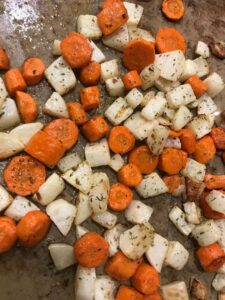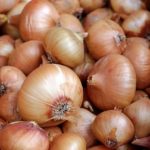Veggies rooted in vitamins, antioxidants, fiber add punch to diet
(The following article was written for and published in the September 16, 2022 edition of Get Healthy, a publication of The Northwest Indiana Times.)
As we notice cooler nights and fall skies, our appetites shift to heartier meals. Soups and stews slowly work their way into our meal plans along with a variety of root vegetables. A change from the delicate greens of summer, these vegetables offer a variety of health benefits as they find their way into some of our favorite comfort foods.
A root vegetable is the underground, edible portion of a plant. Root vegetables include potatoes, carrots, beets, sweet potatoes, onions, shallots, radishes, daikons (white radish), turnips, jicama (Mexican turnip), yams, fennel, Jerusalem artichokes (sunchokes), rutabagas, parsnips and celeriac (celery root). Turmeric, garlic and ginger are also root vegetables. 
A good source of complex carbohydrates, antioxidants and nutrients, this vegetable group may even get the occasional nod from carb counters. Many people, including athletes, children, those needing to gain weight or those who are very active, often feel better when they include a moderate amount of these unprocessed carbohydrates in their diets. For those individuals who have trouble digesting various grains, root vegetables are an option and do not contain gluten. Because of their high fiber content, many of them are considered low-glycemic foods since their rate of absorption is relatively slow.
White potatoes (Russets, Yukons) are a favorite and give you more potassium than a banana or sweet potato, as well as antioxidants and manganese. To get the most nutrients from potatoes, eat the skins and do not deep fry them (sorry French fry lovers). One of my favorite ways to prepare potatoes: Scrub the skins and pat dry; coat with extra virgin olive oil and sprinkle with kosher salt; bake on a pan lined with parchment or on a baking stone, until tender. Serve with a drizzle of olive oil and/or plain Greek yogurt in place of sour cream. Garnish with parsley, chives or your favorite sautéed veggies.
Sweet potatoes are rich in beta-carotene. Beta-carotene, found in plants, is converted to vitamin A, then utilized in the body. Like white potatoes, sweet potatoes also contain vitamin C, antioxidants and a host of beneficial plant chemicals or phytochemicals. The more colorful the vegetable, the higher the phytochemicals. Red-fleshed or purple-fleshed potatoes contain phytochemicals comparable to Brussels sprouts, blueberries or spinach.
Carrots are another big winner in the beta-carotene department. They get their color from antioxidants known as carotenoids that protect eyes and skin. Eaten raw, they rank low on glycemic index (GI). GI is a bit higher for cooked carrots and highest for puréed. Dip raw carrots in hummus for a snack. They are delicious cooked in stir-fries, soups, stews and roasted as a side dish.
Onions are high in vitamin C, antioxidants and fiber. They are closely related to chives, garlic, scallions, shallots and leeks. Used to flavor a variety of cuisines, the taste can range from mild and sweet to strong and sharp, depending on the variety and season. Red and yellow onions are higher in antioxidants than white varieties. 
Beets seem to be gaining more attention due to their nitrite content. Nitrites naturally found in beets are easily used by the body to aid in muscle recovery, improve circulation, lower inflammation and increase physical performance. This is of particular benefit to athletes. Beets help detoxify the body and contain the highest amount of antioxidants. Broccoli and peppers, while not root vegetables, tie with beets in the antioxidant category.
Root vegetables may help with weight loss due to fiber content, which helps you feel full for a longer period of time. Compared to grains, many are lower in calories and less likely to cause a drastic spike in blood sugar when eaten with a balanced meal. Antioxidants help reduce inflammation, thereby reducing the risk of various diseases such as cancer, heart disease and dementia. These vegetables help curb carb and sweet cravings without lots of sugar often found in processed foods. A variety of roasted root vegetables makes a great anytime snack. Consider adding an extra root vegetable or two to your favorite soup or stew.
Roasted Root Vegetables
Ingredients
- 2 pounds (or so) of various root vegetables, peeled or scrubbed and cut into 1-inch pieces. Carrots, potatoes/sweet potatoes, red onions, beets, turnips, whatever combination you like best, or try a “new” vegetable
- 1 head garlic, cloves separated and peeled
- Extra virgin olive oil
- Kosher salt
- Ground black pepper
- Balsamic vinegar (optional)
Directions
Preheat oven to 400°F. Toss cut vegetables and garlic cloves in a bowl with a light coating of extra virgin olive oil and salt, and pepper to taste. Spread the vegetables in a single layer on a baking sheet or stoneware pan (my favorite) or two, depending on the amount of vegetables you have. Roast the vegetables until tender and golden brown, stirring occasionally, about 45 minutes to 1 hour. If desired, drizzle with extra virgin olive oil or balsamic vinegar for more flavor, before serving.


